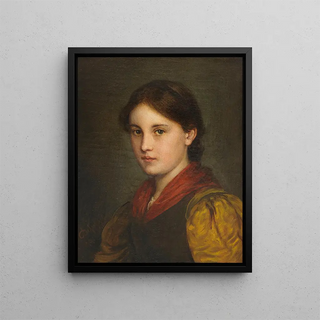Art print | Dirndl - Franz von Defregger


View from behind

Frame (optional)
Franz von Defregger's "Dirndl" canvas is a true masterpiece embodying the spirit and alpine culture. This artwork, both vibrant and full of life, transports viewers into a universe where tradition meets modernity. Through this art print, Defregger does not merely depict a woman dressed in traditional Austrian attire. He captures the very essence of mountain life, with its vivid colors and meticulous details. Contemplating this art print - Franz von Defregger, one feels a deep connection with nature and the cultural roots of the alpine regions, making this piece timeless and universal.
Style and uniqueness of the work
Defregger's style is distinguished by refined painting techniques and particular attention to detail. In "Dirndl," the nuances of color, ranging from warm shades to cooler tones, create an atmosphere that is both warm and lively. Light plays a crucial role in this work, illuminating the face of the young woman while highlighting the rich textures of her traditional costume. The composition is carefully orchestrated, with a harmonious balance between the main subject and the background, which evokes the majestic landscapes of the Alps. This painting is not limited to a simple representation; it tells a story, that of a culture, an identity, and a way of life rooted in the natural beauty of the mountains.
The artist and his influence
Franz von Defregger, born in 1835 in Austria, is one of the most influential painters of the 19th century. His career is marked by a deep attachment to his homeland, which he depicts with unique sensitivity. Defregger mastered blending realism and romanticism, creating works that celebrate the daily life of peasants and mountain dwellers. His style has influenced many contemporary artists, who sought to capture the beauty of folk traditions. By exploring themes related to alpine culture, Defregger also contributed to the valorization of Austrian national identity at a time when nationalist movements were gaining momentum. His legacy endures through his works, which continue

Matte finish

View from behind

Frame (optional)
Franz von Defregger's "Dirndl" canvas is a true masterpiece embodying the spirit and alpine culture. This artwork, both vibrant and full of life, transports viewers into a universe where tradition meets modernity. Through this art print, Defregger does not merely depict a woman dressed in traditional Austrian attire. He captures the very essence of mountain life, with its vivid colors and meticulous details. Contemplating this art print - Franz von Defregger, one feels a deep connection with nature and the cultural roots of the alpine regions, making this piece timeless and universal.
Style and uniqueness of the work
Defregger's style is distinguished by refined painting techniques and particular attention to detail. In "Dirndl," the nuances of color, ranging from warm shades to cooler tones, create an atmosphere that is both warm and lively. Light plays a crucial role in this work, illuminating the face of the young woman while highlighting the rich textures of her traditional costume. The composition is carefully orchestrated, with a harmonious balance between the main subject and the background, which evokes the majestic landscapes of the Alps. This painting is not limited to a simple representation; it tells a story, that of a culture, an identity, and a way of life rooted in the natural beauty of the mountains.
The artist and his influence
Franz von Defregger, born in 1835 in Austria, is one of the most influential painters of the 19th century. His career is marked by a deep attachment to his homeland, which he depicts with unique sensitivity. Defregger mastered blending realism and romanticism, creating works that celebrate the daily life of peasants and mountain dwellers. His style has influenced many contemporary artists, who sought to capture the beauty of folk traditions. By exploring themes related to alpine culture, Defregger also contributed to the valorization of Austrian national identity at a time when nationalist movements were gaining momentum. His legacy endures through his works, which continue






